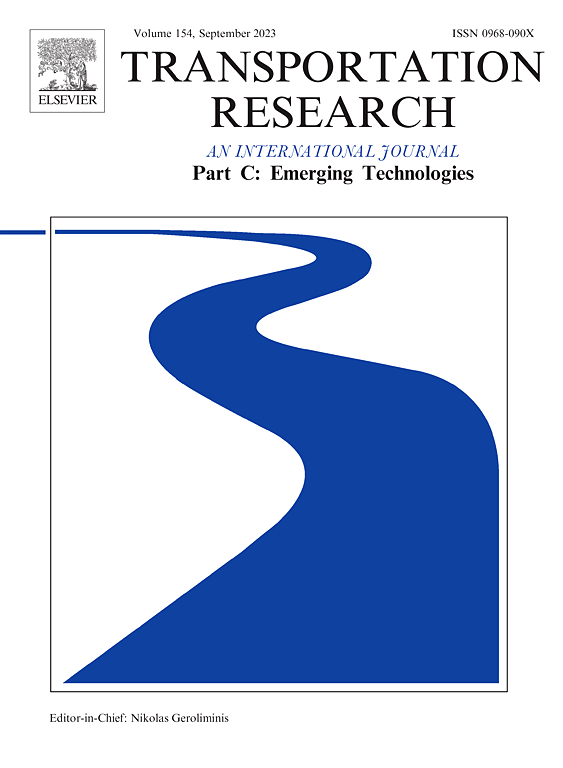Estimating real-time traffic state of holding vehicles at signalized intersections using partial connected vehicle trajectory data
IF 7.6
1区 工程技术
Q1 TRANSPORTATION SCIENCE & TECHNOLOGY
Transportation Research Part C-Emerging Technologies
Pub Date : 2025-06-27
DOI:10.1016/j.trc.2025.105251
引用次数: 0
Abstract
Emerging connected vehicle (CV) technologies offer unprecedented opportunities to estimate various traffic states, enhancing traffic management and control. Among these states, a particularly critical yet underexplored one is the number of holding vehicles—vehicles that, based on their projected trajectories using cruise speed, should have been discharged at any instant of interest but are instead impeded and remain undischarged. Accurately estimating this quantity is essential for real-time traffic state monitoring and control, as it directly reflects the effectiveness of traffic flow at intersections. However, the prolonged transition period implies a mix of CVs and non-connected vehicles (NCs) within transportation networks, resulting in incomplete traffic information. To address this challenge, this paper proposes a generic and fully analytical CV-based holding vehicle (CVHV) model to estimate the number of holding vehicles at any instant of interest, relying solely on partial CV trajectory data. The CVHV model accommodates any signal plans, CV penetration rates, and traffic demands. Two sub-models, CVHV-I and CVHV-II, are derived to account for different holding vehicle patterns at any instant of interest falling within the effective red or green of a signal group, respectively. Each sub-model handles various holding vehicle patterns, including holding vehicle components such as stopped holding CVs and NCs, and moving holding CVs and NCs. Comprehensive numerical experiments in VISSIM validate the effectiveness of the CVHV model under varying volume-to-capacity ratios, CV penetration rates, and signal timing configurations. Its practical applicability is further demonstrated using the real-world Next Generation Simulation dataset. Additionally, the application of the proposed model to estimating the real-time total number of vehicles in a lane and to a simple illustrative example of CV-based adaptive signal control highlights the significance of accurately estimating the traffic state of holding vehicles.
利用部分互联车辆轨迹数据估计信号交叉口等待车辆的实时交通状态
新兴的互联汽车(CV)技术为评估各种交通状态、加强交通管理和控制提供了前所未有的机会。在这些状态中,一个特别关键但尚未得到充分开发的是持有车辆的数量——根据它们使用巡航速度的预测轨迹,车辆本应在任何感兴趣的时刻排放,但却受到阻碍并保持未排放。准确估计该数量对实时交通状态监控至关重要,因为它直接反映了交叉口交通流的有效性。然而,过渡时间的延长意味着交通网络中cv和非联网车辆(nc)的混合,导致交通信息不完整。为了解决这一挑战,本文提出了一种通用的、全分析的基于CV的持有车辆(CVHV)模型,该模型仅依赖部分CV轨迹数据来估计任何感兴趣时刻的持有车辆数量。CVHV模型适应任何信号计划、CV渗透率和流量需求。衍生出CVHV-I和CVHV-II两个子模型,分别用于考虑在信号组有效红色或绿色范围内的任何感兴趣时刻的不同持有车辆模式。每个子模型处理各种持有车辆模式,包括持有车辆组件,如停止持有cv和nc,以及移动持有cv和nc。VISSIM中的综合数值实验验证了CVHV模型在不同体积容量比、CV渗透率和信号时序配置下的有效性。它的实用性进一步证明了使用现实世界的下一代仿真数据集。此外,将该模型应用于实时估计车道内车辆总数和基于cv的自适应信号控制的简单示例,突出了准确估计等待车辆交通状态的重要性。
本文章由计算机程序翻译,如有差异,请以英文原文为准。
求助全文
约1分钟内获得全文
求助全文
来源期刊
CiteScore
15.80
自引率
12.00%
发文量
332
审稿时长
64 days
期刊介绍:
Transportation Research: Part C (TR_C) is dedicated to showcasing high-quality, scholarly research that delves into the development, applications, and implications of transportation systems and emerging technologies. Our focus lies not solely on individual technologies, but rather on their broader implications for the planning, design, operation, control, maintenance, and rehabilitation of transportation systems, services, and components. In essence, the intellectual core of the journal revolves around the transportation aspect rather than the technology itself. We actively encourage the integration of quantitative methods from diverse fields such as operations research, control systems, complex networks, computer science, and artificial intelligence. Join us in exploring the intersection of transportation systems and emerging technologies to drive innovation and progress in the field.

 求助内容:
求助内容: 应助结果提醒方式:
应助结果提醒方式:


